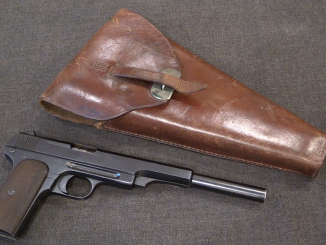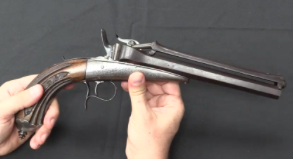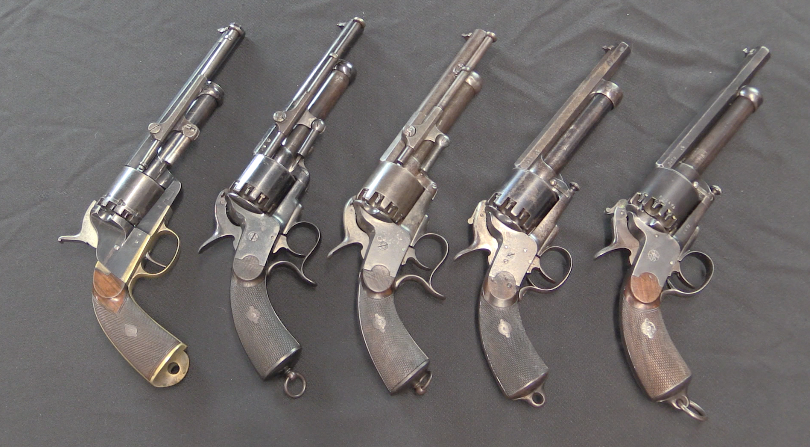When John Browning licensed his handgun patents, the North American rights were granted to Colt, and the Western European rights to FN in Belgium. Browning provided the patents and patent model guns to the companies, and they were then free to interpret the design however they thought best. In the case of the shrouded-hammer blowback system, the Colt interpretation (the Pocket Hammerless) was a civilian concealed pistol in .32ACP, while the FN interpretation (Model 1903) was a substantially larger gun in 9×20 Browning Long intended for military service.
The locked-breech patent was the same. Colt developed it into the Model 1911 adopted by the US military, and FN built a slightly smaller version in 9.65x23mm intended for European military service. However, while the Colt pistol became tremendously popular, FN’s development was disrupted by World War One, and never completed in its aftermath. Only a couple dozen examples of the Grand Browning, as it was called, were made before the war, and just a few survive today. We will never know how European militaries would have responded to a Browning locked-breech pistol at the time…




Another potential gone out the window. The later GP35 became what the Grand Browning could have been (as a popular export side-arm, assuming a successful cartridge development went with it). Did I mess up?
“(…)popular export(…)”
I doubt. FN-Colt agreement mean that this automatic pistol might be exported only to European countries. In that time nationalism was high in Europe, so all countries which deemed themselves worth title of serious European power very unlikely to adopt it, unless urgent operational need. Other Europeans countries often already have adopted model of military automatic pistol – Denmark has Bergmann–Bayard, Sweden has Husqvarna pistol m/1907 and so on. Finally if even they managed to find customer size of production would be probably modest, c.f. number of Kongsberg Colt made per year: https://en.wikipedia.org/wiki/Kongsberg_Colt
Ian, any pictures of the cartridge? The googles isn’t of much help on this one
Here: http://municion.org/browning/9_65Browning.htm
The licence to FN incidentally complicated European adoption of the M1911. Norway finding that its inquiries to Colt about domestic Norwegian production of it were passed to FN and the extra complication / negotiations delayed its production into WWI. There being also quite widespread other European interest. Though I do not know to what degree the FN connection deterred them
Was it not so, provided that my memory isn’t playing tricks on me, that the Norwegians did make a deal with Imperial Germany and thus aquired the tools to produce the Kongsberg version of the 1911. The Germans did not have use for the tooling of a gun in a calibre they didn’t use and they recognized the possibility to earn badly needed currency when selling the machinery to Norway.
It would be interesting to compare the Grand Browning to the Kongsberg, although they are in different calibres.
I seemingly remember that Browning was working on a .40″ caliber cartridge in his prototypes that led to the 1911, interesting that both Colt and FN pitched a cartridge not too far off the .40 S&W to the future Yugoslavs. There is nothing new under the sun…
“(…)seemingly remember that Browning was working on a .40″ caliber cartridge in his prototypes that led to the 1911(…)”
Are you thinking about 9.8×23 Colt cartridge, as shown there:
http://municion.org/Colt/9_8x23Colt.htm
?
In an alternative universe, the Grand Browning goes into production in 1913 for Montenegro, then the Germans invade and tell FN they’re going to build them in 9X19 mm for das Heer. there are now thousands of Imperial German Brownings out there. Does the High Power ever get made….
“(…)Does the High Power ever get made….(…)”
Initial spark, which would eventually lead to HP, was French small arms replacement programme started yet in 1921 year. One of desired weapon was automatic pistol which should: fire 9 mm or so bullet, with weight 125 gr and muzzle velocity above 1184 fps, magazine holding at least 15 cartridge and possibly has detachable stock.
https://www.smallarmsreview.com/display.article.cfm?idarticles=1077
Naturally it was concluded based on experience of Great War, so question is how much Great War differs in your timeline.
Unless some super genius changes the game plan for the Allied Powers or the Central Powers, things more or less will end similarly: EVERYONE GOES BANKRUPT! And in this version of the Great War, keeping America out of the fight would require Germany to NOT indulge in unrestricted U-Boat activity and also NOT ask Mexico to try and snatch Texas back.
Excellent train of thought and …no they don’t
The cartridge is elephant. The ideological analogue is 9mm Mauser and, later, 10mm. With the same vagaries.
And the gun itself, for sure, sports-accurate. At least the design allows this. By analogy with VIS and some TT33.
In general, it seems to me understandable why he was thrown out the window…
FN pistol seems having an integral main spring housing at back of the grip handle insread of the removable sliding unit used at Colt’s.
“…integral main spring housing at back of the grip handle…”(C)
I do not think so.
This is an unjustified complication of production.
The video (1,55 and 2,17) clearly shows that this is a separate part.
Just the quality of the finish significantly exceeds the serial 1911.
On the Colt 9.8mm vs. FN 9.65mm, looking online it seems collectors who have both say they are dimensionally identical, Colt having used a groove to groove bore diameter for their designation while FN used land to land. Loading wise, the 9.8 came in either a round nose 150gr at about 800-900 fps or a 130gr at about 1200, while the 9.65 like you said came in a 115gr semi-truncated at about 1300 fps.